Here is a link to our Google Slides presentation. For our artifact we chose to make podcasts each hosted by two members of our group. Check out this screen cast made with ScreenCastify!:
Author: missmya (Page 1 of 2)
This week our class presented on a number of platforms useful for creating classroom portfolios. These consisted of class websites, Seesaw, and Class Dojo. Some benefits all groups brought up for these portfolios were:
- Increased communication with parents and families, especially for kids with separated families of children in care
- Students can have access to class materials at home or on vacation
- You can share important information about upcoming events in your school or classroom
Class Website
Dannika and Sarah presented their class website they created using WIX. While they had some issues setting up this site, the final product seemed very well put together. There main page was very organized with direct links to all of their pretend class subjects: math, science, literacy, social studies, and upcoming assignments. My favorite part of their site was the mint lesson! I think it’s adorable and would absolutely do a similar lesson in my class. One benefit to this website is the option to password lock certain pages so that only certain students or parents can have access. This would also be a useful feature for posting assignments that you don’t want students to have access to yet. I like the website design for class portfolios over the other two apps – Seesaw and Class Dojo – because anyone can have access to it not just the students and families in your class. I think based on the feedback Dannika and Sarah shared about the challenges of setting up this site, a social media page on platforms like Instagram or Facebook might be more beneficial, but that could be difficult as students 12 and under cannot set up profiles on these platforms.
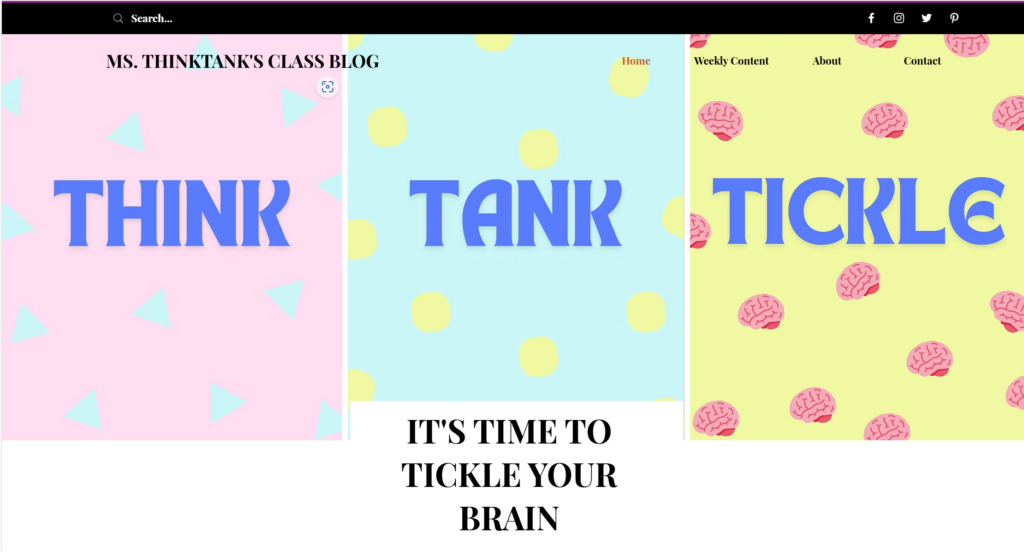
Seesaw
For Josie, Kenna, and Laurens presentation, they shared about their experience using Seesaw. This is a platform supported and used across SD5 and SD6 which makes it very easy to access and set up an account if you are working within these districts. Some features they liked about this classroom portfolio platform were:
- It’s very user friendly
- It can be used at home which prompts students to share their work with their families
- Teachers can use this platform to message the whole class, small groups, or individual students or family members of students
- Teachers can also use this platform to provide instant feedback on students work
- Teachers can set “office hours” so students and families aren’t trying to contact the teacher at ridiculous hours of the night
- The resource library is also a neat feature for teachers to have access to thousands of teacher created and tested activities
Based on this groups feedback on this platform I would definitely consider using it in my classroom, especially if it is a platform supported by my school district. I love the idea of providing my students with a collective space for them to keep their work for the rest of their school years. Some potential cons that this group shared with us were:
- Because this is an online platform it can be difficult for families who don’t have consistent internet access to be involved in
- Also, as always with data storing platforms there is a risk of a data leak
Overall, this was a great presentation and I will absolutely consider seesaw for future use.
Class DOJO
Carter, Connor, and Eva did their presentation on Class DOJO. This is a similar platform to Seesaw as it provides students and parents access to teacher portfolios they’ve set up for the class. One thing I loved about this presentation was how each presenter looked at it from a different point of view. Each of them signed up for either the teacher profile, the student profile, or the parent profile, and put the program to the test! Each of them had some personal reviews based on which perspective they took:
Teacher review – A little cluttered not the most user friendly. Cool feature: say you were making an event (like a field trip), you can create a section for parents to sign up as chaperones online – saves paper!!!
Parent review – would opt for seesaw (easier navigation), parents can’t use dojo islands. Lack of resources for families that don’t have tech access
Student review – safer and a lot more controlled, curriculum was pretty basic, tutorial, game controls need some work.
Which one to use?
Overall, I think the idea of creating an online class portfolio is an excellent idea. Of course, I think a teacher should remaining cautious to not fully depend on it and always have a physical back up of things like student info, lesson plans, student grades, and permission forms. Despite some of the cons of online portfolios, I do believe they can still be a useful tool in classroom. Based on the expert opinions of my class mates I believe I would use Seesaw to create my online classroom portfolio.
In today’s class, we experimented with gamification and some apps that come along with that. Prodigy is an RPG style game with the intentions of engaging kids in math and literacy exercises, through a fun, inclusive, intrinsically-motivated way. I typically do not gravitate towards video games especially not of this style, however the reviews I over heard from my peers were very positive. Also, the statistics they share online are quite promising. Students are twice as likely to enjoy learning math with prodigy. In one school district, 68% more math skills were master in just one month of using prodigy. And, 96% of parents and teachers are satisfied with what their student is learning on prodigy. Another positive is that it’s free to register, but students do need to make an account which can get sticky with privacy requirements based on your district. I do have a few concerns with a Prodigy and programs like it. My first issue is that kids are already on screens way too much. According to both the AACAP (American Academy of Children and Adolescent Psychology) and Independent UK children spend 4-6 hours per day on their screens. When you consider that 8-10 hours of their 24 hour days are spent sleeping this is a pretty crazy statistic. I think especially since the outbreak of COVID-19 we have seen some devastating impacts on the physical and mental wellbeing of our youth and a lot of it is due to the amount of time they spend cooped up with a screen in front of their face. Another concern I have, is that eventually these kids who do not have a particular liking for math will need to still participate in math class without the added benefit of getting to play a video game while they do it. Will games like this cause students to develop a dependency on the dopamine rush provided by these games? Will they ever learn to become intrinsically motivated on their own, or are we slowly pushing students down the path of needing constant approval and reward for completing a task? These are questions that I think only time will tell but I am definitely interested in using Prodigy as a math and English learning tool, however I will approach this tool with caution.
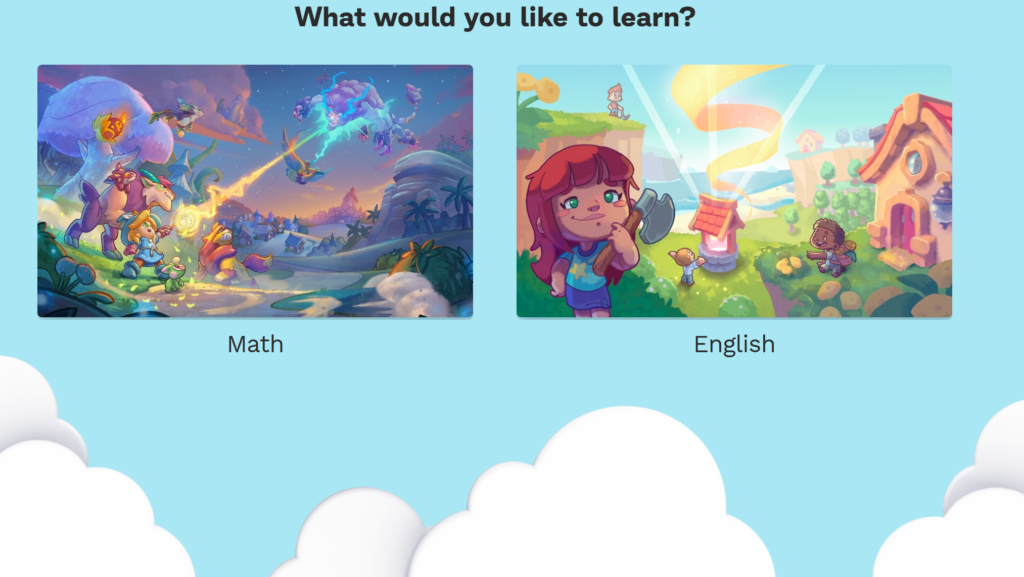
This Week, our class visited the design lab in our local district. This eye-opening experience really got me thinking about how tech can be used in the classroom. I am not well versed in technology by any means, and I find it quite a hurdle when faced with a problem surrounding technology. However, the work we did at the design lab showed how education in BC is really starting to look at the innovative side of technology. While we were there, my group built a train set. The challenge (as per assigned by the design lab coordinator) was to build a track that looped 3 times. We were also given little coloured tabs and an electric train that when it sensed the colours would perform different tasks (yellow= train whistle, red = stop, blue= stop and gas up, green = reverse) we were able to come up with some pretty cool designs that didn’t make a full 3 loops but 2 and a half and that felt like a pretty cool accomplishment. I would love to bring a class here again in the future. I think it would be awesome for teaching students the beginnings of code, teamwork/team building, problem solving, and how to better understand the world through the lens of technology. I was specifically interested in the cardboard building tools and would love to create a lesson around this. I think I would make it a social studies lesson and start by explaining the foundations of a community. Talk about what sort of things a community needs to survive and thrive and then challenge the class to build their own community where everyone plays a role. Here’s a tour of our train track!
Howdy mathematicians! Hope you’ve learned lots and got your heart rate up. This is PE is the New Math checking in one last time. Over the course of this blog, we’ve learned:
- What is physical literacy, and why do we care? – this section looks at the importance of physical literacy skills and the development of these skills at a young age as well as how they can benefit the kids in your life
- We interviewed a local teacher and learned about her unique way of incorporating physical activity into her classroom every day! Check out this blog post to donate to this fun and innovative program.
- We looked at the experience of girls in sports through examining statistics from The Rally Report and interviewing girls in kindergarten, grade 5, and high school.
- On top of the importance of physical activity and academic success, we also looked at how exercise helps promote mental wellbeing via manufacturing all the good brain juices.
- We also looked at how an indigenous perspective can be considered in your PE class through use of the medicine wheel, and by implementing some fun indigenous games that are relevant to your local nation.
Now for the big challenge. What do we do now? Well hopefully, if you’ve followed along this far, you understand how important it is to get kids up and moving whether you’re a parent, teacher, coach, administrator, or just anyone with a passion for sports. This brings me to my two summary questions:
- How do you incorporate physical activity in to your classroom?
- How do you get your kids involved in sports at a young age?
This post acknowledges the barriers around this that are highlighted throughout this blog, and gives some suggestions on how to overcome these barriers.
Physical activity and the classroom:
With so much demand coming from parents, principles, the curriculum and your students, it may seem impossible to incorporate anymore movement in your classroom. Of course, if you’ve been following, it is more crucial now than ever that we get kids up and moving. Here are a few strategies I’d suggest:
- Implement Brain breaks into your schedule throughout the day. Brain breaks are 5 to 10min long themed videos that get kids moving. themes vary from Roblox, to Inside Out, to Mario and many more. There are countless videos available for free on You Tube and it even gives you, the teacher, some time to transition into your next lesson. These short clips would be the perfect way to start your morning or to introduce movement throughout the day. I’ve attached some of my favorites below:
- Make your PE class fun, engaging, and as accessible as possible. Every child needs to move. If your PE lesson doesn’t fit the abilities of everyone in your class you must ADAPT.
- Get outside. While the classrooms are very useful for keeping kids organized and providing a warm dry space to learn, us humans were not engineered to be inside nearly as much as we are. There are significant deficiency’s that we suffer the more we are stuck inside and sometimes the best classroom management skill is getting out of the classroom.
- If a lesson doesn’t have to be done with the kids seated in one place, then don’t! Just by simply weaving bits of movement into your daily lessons will make a difference.
Kids sports at home:
Of course, we all face different challenges whether its with finances, schedules, or other life demands, but even at home it is our job as parents to ensure our kids are getting the physical activity they need. Here are just a few ways that you can get your kid involved in sports:
First, is the issue of finances. Money is always a factor and unfortunately kids are expensive. Luckily, there are a variety of non-profit programs that you can both donate to and apply for grants from that will fund your child in sports! here is a little more on one of my favorites:
So now that we’ve figured out the finical side of things, what sports do we even put our kids into? In post 2 – what is physical literacy – we learned that the more a kid does, the better their physical literacy. So, sign them up for it all! Having kids involved in as many sports as possible at a young age drastically increases their chances of remaining active throughout their life. Here are just a few local clubs that provide sports and activities for kids aged 3 – 18:
- Rugby – The Rocky Mountain Rogues provide Rookies Rugby for kids aged 4 – 14. this NON-CONTACT rugby program is inclusive and safe, and gets kids involved in the sport by teaching them the basics so they can have fun and create life long friends and memories.
- Soccer – The East Kootenay Soccer Association (KEYSA) provides both an indoor fall league and an outdoor spring league. Their mission is “To promote, develop, and facilitate the game of soccer for all players regardless of gender, age and ability.” Their house league is a non-competitive league designed for kids aged 3 – 16 and their rep league is a competitive program for kids aged 9 – 18. Kids Sports Eligible.
- Baseball – Cranbrook Minor League Baseball offers softball and baseball leagues in the spring. Their mission: To promote the game of Baseball / Softball in a fair and equal manner to all involved by encouraging all players to develop and enhance the Baseball / Softball skills through FAIR PLAY, SPORTSMANSHIP, TEAM PLAY, CITIZENSHIP, RESPONSIBILITY & COMMITMENT, and QUALITY COACHING. The nice thing about working with Cranbrook Minor League Baseball and KEYSA is they both use the program RAMP for their registration, so if you make an account with one, you’re all set to register for the other! Kids Sports Eligible.
- Climbing – Arq Mountain Center provides a variety of afterschool programing starting with dynostars – a preschool based program for kids 3-5 – going all the way up to Summit – a non-competitive program for kids in grade 7 and up. They also offer Arq Angles, a girls only program for grade 7 and up. There are also a variety of Semi-competitive and competitive programs offered. Kids Sports Eligible.
- Swimming – Cranbrook Tritons Swim club, has been running since the 70s and gives kids the chance to participate in a variety of non-competitive or competitive swimming programs. There are no age requirements, but it is recommended that your child completes Red Cross Level 4 before registering.
These are just a few of the sport options available in Cranbrook BC. Do your research! Get your kid involved in as many sports as possible. There’s a sport out there for everyone. Well that’s all for now, this is PE is the New Math signing out!
This week our class attended a local elementary school to help a grade 2 class with their Take Me Outside Day activity. I love this program and the initiative it shows for promoting outdoor learning. My ultimate goal as an aspiring educator is to eventually run my own K-6 (maybe even K-12) outdoor school. I believe that nature can teach us so much more than we give it credit for, and that we waste so much potential when we stuff kids into a stuffy classroom. It was fun to get outside with the students and connect with them, but some of my connections lead me to believe that this activity could have been executed a lot better. Most of the kids were pretty upset that they didn’t see any animals and some of them stated that “If we would have gone to the lake, we would have seen some”. It was pretty cool though getting to talk to them about this and asking questions like “Why do you think the animals like the lake better?” or “Why don’t you think we are seeing as many animals here?” they all gave me fairly accurate answers such as: “Well the animals like the water for drinking and because they can find lots of food around there” and “The animals don’t want to come around here because there’s lots of dogs that come here”. It was nice to hear them making these kinds of connections to nature and their environment. I also felt like the boundaries were way too strict especially considering the adult-to-kid ratio was basically 1:1. I felt like we didn’t need a boundary but rather a rule of “Stay with in eyesight of your adult”. Also, the area that was enclosed by the boundary was pretty sad. Both of my students were finding more litter than they were natural materials for sculpture building. Overall, great activity, poor execution.
In researching the Take Me Outside Day website, these were some cool activities I found that I’d love to try in my classroom one day:
- Invasive Species Scavenger Hunt by ISCBC
- Ripples of Change – a lesson on the severity of climate change and how we can make ripples of change in our community.
- Project Learning Tree activity guide book – specifically the back yard safari activity would have been great for this class!
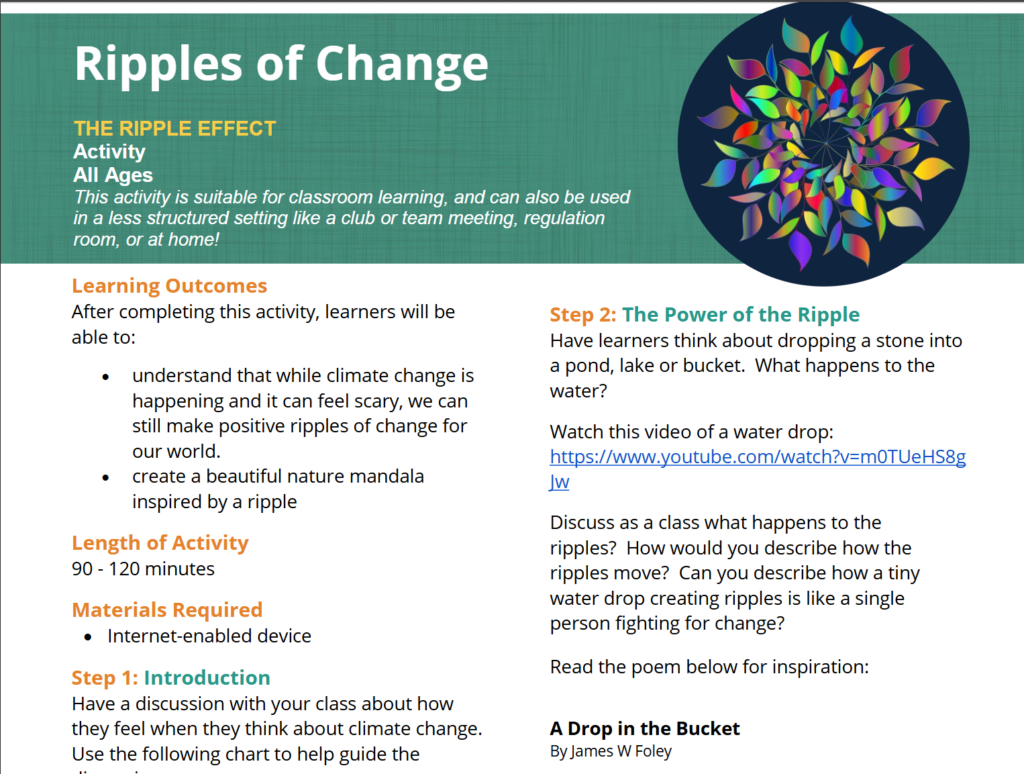

And we’re back for another post from PE is the new Math. Today, we’re touching on a hot topic in the world of education: incorporating First Peoples learning principles in the classroom. Specifically, how do we incorporate an indigenous perspective in PE class? This week will include how we can encourage indigenous principles in day-to-day physical and health education, as well as a few indigenous games you can play in your class (Important Note: Not all indigenous cultures and customs are versatile throughout Canada. It is important that you research the traditions of your local nation before teaching a first peoples-based lesson).
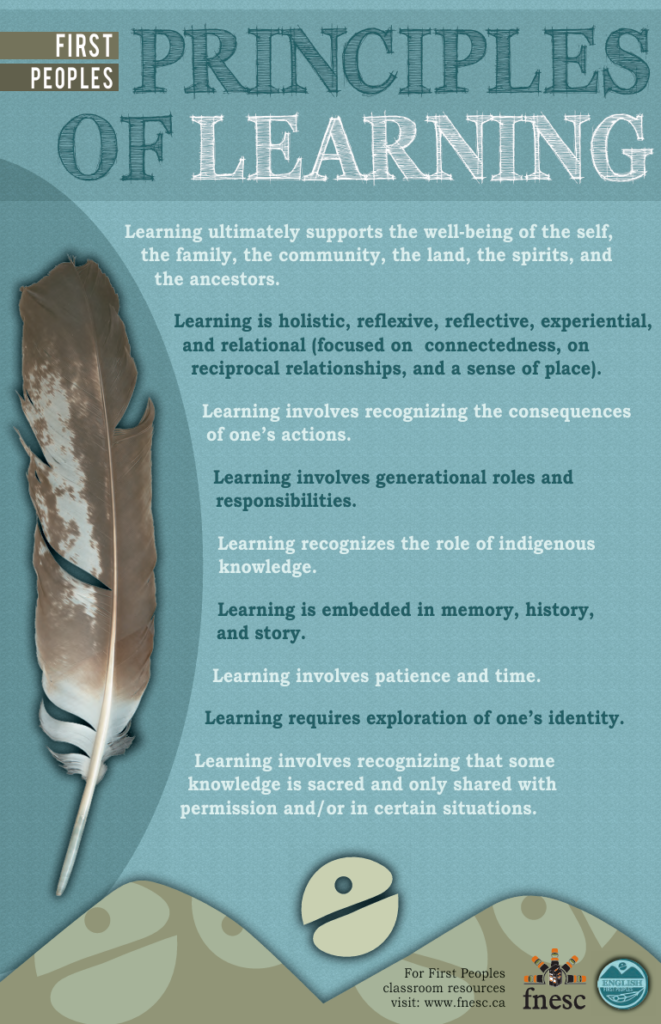
The Medicine Wheel
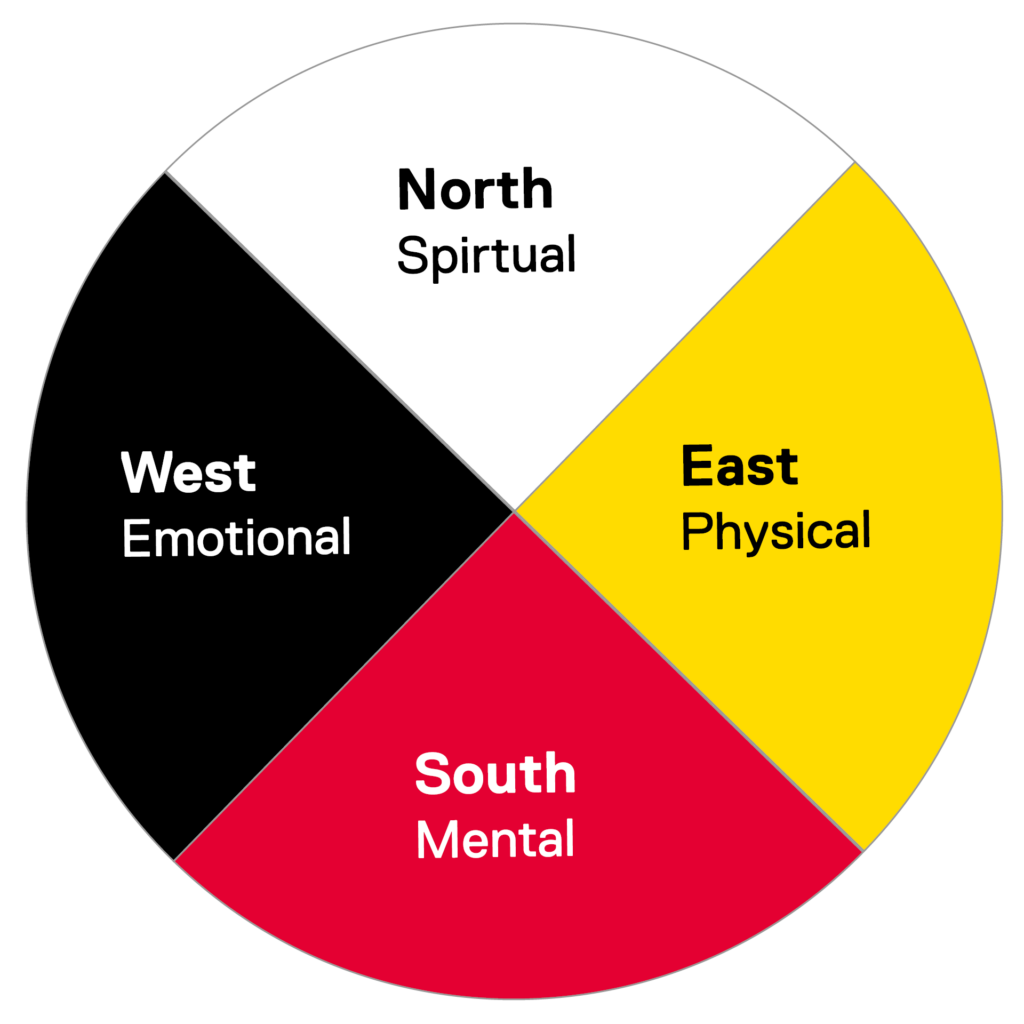
The first tip I offer for incorporating indigenous perspective in your classroom can be used daily. The medicine wheel (AKA. Sacred Hoop or the Wheel of Life) is an important symbol recognized by many indigenous tribes throughout North America. It signifies the cyclical and the interconnectedness of all things. Recognizing this interconnectedness helps us to strive for a good life for ourselves, our families, and all people (Manitoba First Nations Resources 2008 p.111). Each section of the medicine wheel represents a direction – North, West, South, East – and each state of being – mental, spiritual, physical, emotional. The importance of the circle is that all 4 quadrants have to be balanced and fulfilled to produce a happy and healthy life. What is interesting to me about the use of the medicine wheel in regards to exercise and health is the emphasis placed on the mind-body connection. In his book Spark, Dr. John J. Ratey speaks about this mind-body connection like it is a brand new invention, and in the world of the western science he speaks to it is! However, the medicine wheel provides direct evidence that this important practice that the colonial races of North America are just now realizing, has been a traditional practice of indigenous cultures across North America for centuries. So how do we bring this into the classroom? In his text, Physical and Health Education in Canada, Joe Barrett, suggests using this tool as a way of fostering self awareness in your students every day. Ask students how they feel they participated in each quadrant based on the given activity for that day. You can do this in groups, having each student mark on a scale of 1 to 10 on a white board, or individually by having each student mark how they feel on a paper handout. This simple mindful practice/assessment tool can be practiced daily. Make sure to discuss with your class the important significance of the medicine wheel, maybe even have a local elder come into your class to talk about it.

Indigenous Games
Below you will find two lesson plans for indigenous games sourced from the Physical and Health Education In Canada web resource. These activities are inspired by Blair Robillard, author of Kihcite Metawewina: Playing with a Great Heart, a collection for traditional and contemporary games played across Turtle Island.
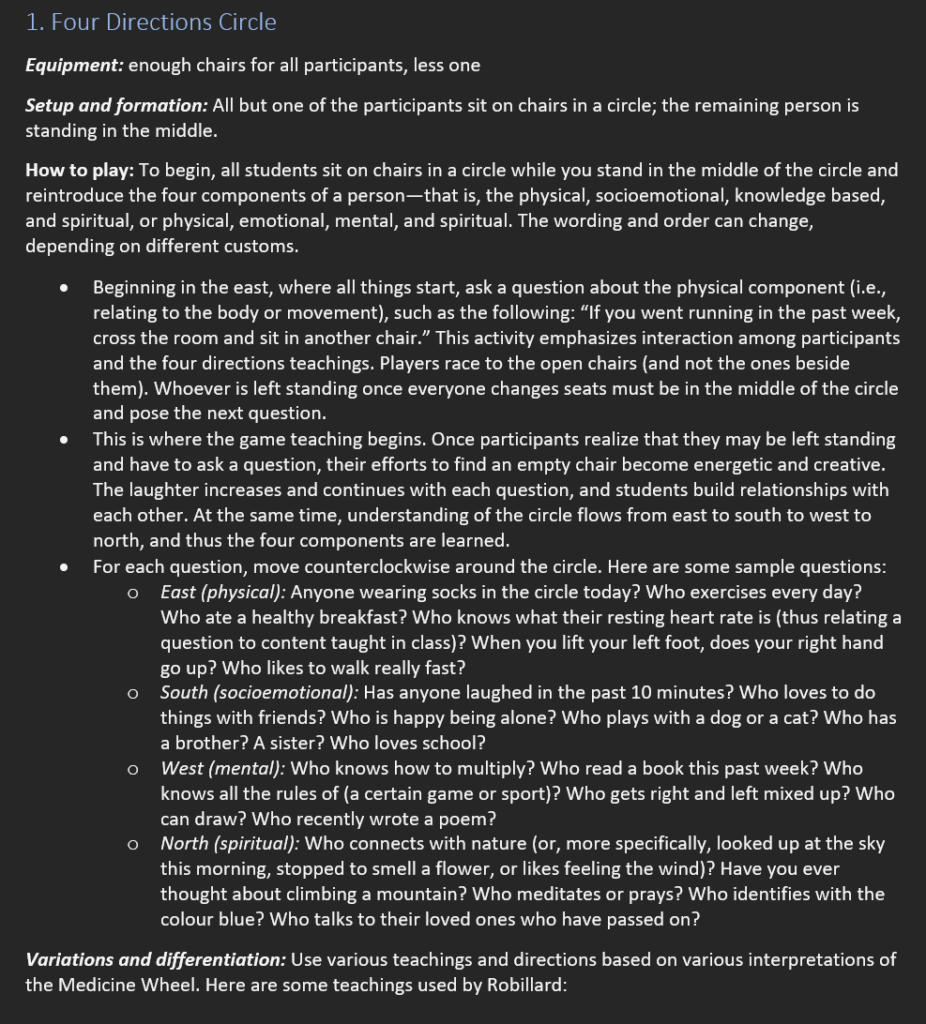
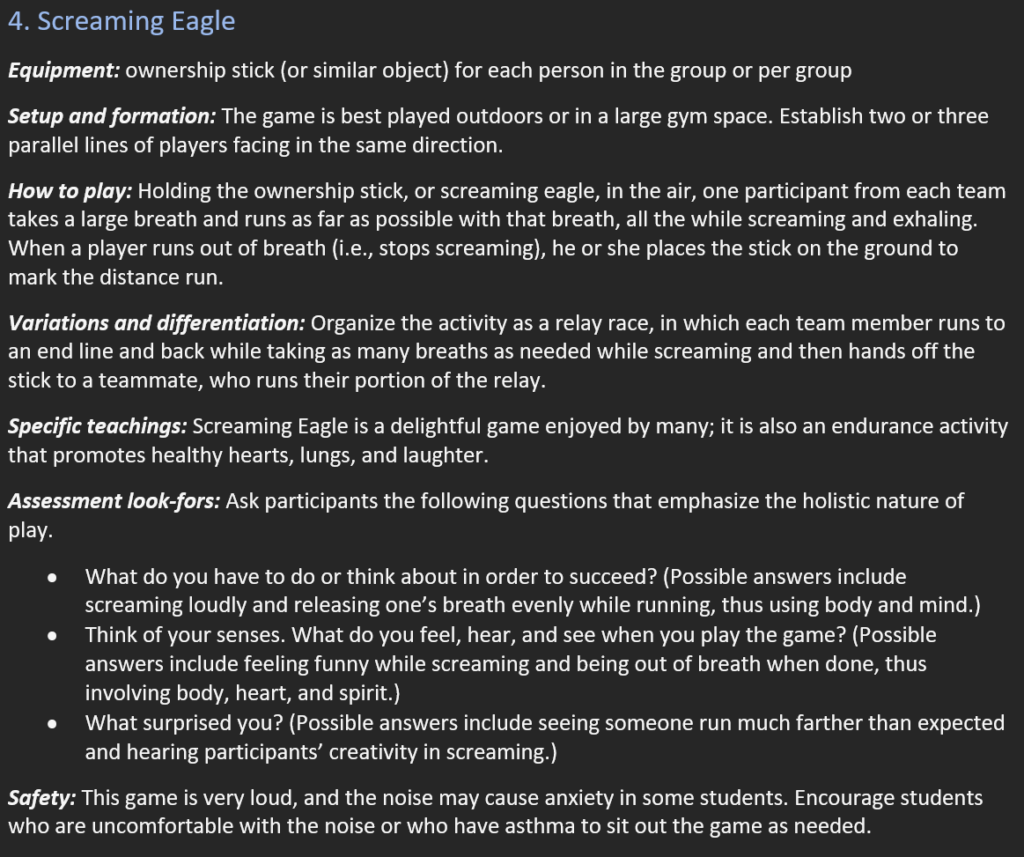

School Wide Initiatives
In June of 2023, the Ktunaxa Nation and the College of the Rockies held a day of traditional sports. This initiative brought together folks of all backgrounds to compete in a fun and friendly environment and learn about the local knowledge and culture of the Ktunaxa people. Traditionally, games were used as ways of teaching survival and life skills. Now, these games are still played by the Ktunaxa people as a means of reconnecting with their culture. This Initiative could easily be recreated in your own school. June is the perfect month to do it as it is indigenous history month, but any time is a good time to incorporate culture into your classroom and school. Consider reaching out to your local nation or band and get in contact with local knowledge keepers and elders. Organize a day or half-day with your principle when you can have that elder attend your school, bring any required equipment, and teach staff and students in your school about significant indigenous games relevant to their culture.
Recently there has been a lot of controversy around AI. How is it being used? Are students using it to teach? What sort of environmental impacts does it have? Will a technology like this eventually take over the world? It is important to remember that with every unknow comes a risk. Despite the risks of AI in the classroom I do believe there is a time and a place for it. Believe it or not, we’ve already been using AI in the classroom! The first task I believe AI is useful for is generating ideas. Although I think that it’s important for kids to learn how to be creative and imagine ideas on their own, when certain assignments or classes might not be super interesting to them it could be challenging to develop ideas on something you’re not necessarily passionate about. I also feel like this should have strict expectations surrounding it and should not be used for kids grade 3 and under as their imagination is still very important in those younger years. Another tool I absolutely love and use for myself quite a lot is Grammarly. This can be really helpful for students in writing assignments as it helps them edit all sorts of different types of writing. One feature of Grammarly that I believe can be really useful to educators is the plagiarism checker. This is an AI tool that automatically scans all your students writing for plagiarism. You need to be cautious with this one however, because it isn’t always the most accurate and only flags things that could be plagiarized. On the topic of useful teacher AI platforms, MagicSchool. This is a generative AI tool designed specifically for educators. It has a ton of great features such as report card comment creator, cheesy joke creator, song creator, and much more. One tool that I think I will find particularly helpful in my classroom is the rubric generator. This will help me create rubrics easily and on time so that my students have a clear outline of my expectations for each assignment, before they even begin said assignment. Here is one I created for this assignment in less than 5 minutes!

Howdy pals! Here again on PE is the new Math. In post 2 we discussed how physical activity improves academic success, but what can sports do for supporting our student’s mental health? As it turns out, the effects of physical activity on the brain are astronomical and we can see so many positive results just from exercise. This includes an increase in cognitive function, decrease in depression and suicidal thoughts, improved self-confidence, improved memory and executive function and overall improved mental wellbeing. Better Than Yesterday is an educational YouTube channel based around the idea of self-improvement.
This video on the benefits of physical activity and many more of Adam Del Duca’s videos are perfect resources for any classroom (But as always make sure to review a video in full before sharing with your class). But lets take a look at what Adam has to say about sports:
- Physical activity is an essential part of our lives. Though we spend so little time being physically active, we did not evolve this way. This is portrayed in our society through a grotesque increase in illness:
- 65% of Americans are obese
- 10% have type 2 diabetes
- Inactivity is slowly killing or bodies and brains and physically making our brains smaller
- Benefits of physical activity include:
- Increased brain mass
- Improved ability learns and absorb information (Like we discussed in post #2)
- Decrease depression and stress response
- Prevent cognitive decline and Alzheimer’s
- Stabilize mood through hormone balance in women
- If physical activity could come in a pill form, it would be the drug of the century
- “Exercise is like taking a little bit of Prozac and a little bit of Ritalin” – Dr. John Ratey
- Exercise not only increases but balances neurotransmitters such as: serotonin, norepinephrine and dopamine.
- Aerobic activity also increases Brain Derived Neurotrophic Factor
While the Better Than Yesterday video summarizes that these positive benefits of physical activity only come from high-intensity aerobic activity (which he defines as getting your heart rate up to 80% of it maximum capacity). However, I would argue that there are also lots of benefits from anaerobic activities such as stretching and yoga. Not only will this make your body more fit for participating in aerobic activities, but it also has a lot of the same psychological benefits as aerobic activities such as a decrease in depression and anxiety. Here is a Ted Talk by Krishna Sudhir that dives deeper into this.
This week our class was granted the opportunity to work with two grade 3 classes from Marysville Elementary to create stop motion videos. While we were there, we got to meet teachers, the principle, and the lovely students. The past few weeks I’ve felt very stressed, lost and there was lot of doubt in my mind about whether I am on the right path, but this experience made me feel very excited and confident that I am on the right track to being an excellent educator. This experience was very good for exposing me to the SD6 environment, where I haven’t spent much time. It was also a great way to get some teacher tips, fresh from the source, on classroom management, job applications, and becoming an excellent teacher. When thing I would have changed was maybe having more time because my group of students had some excellent ideas for our stop motion, but we were unable to execute all of it. I believe this is a very important experience for all teacher candidates and should be included in every course. In conclusion, if I were to do this again, I wouldn’t change much other than trying to get more time or even doing it in 2 sessions. I also would have liked to slow down at the beginning to do some work on learning names because I genuinely don’t remember one of my students’ names. Overall, a great experience and I’m looking forward to working in schools again in the future.
